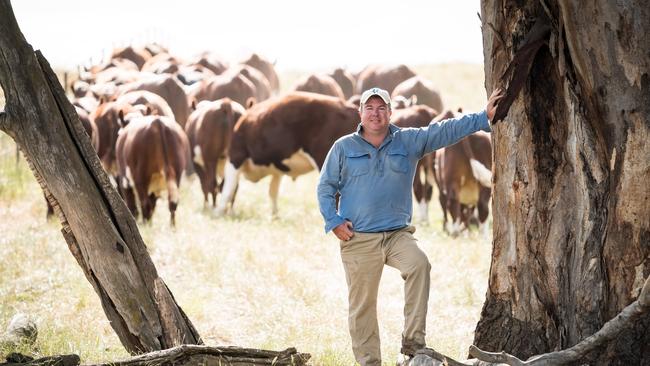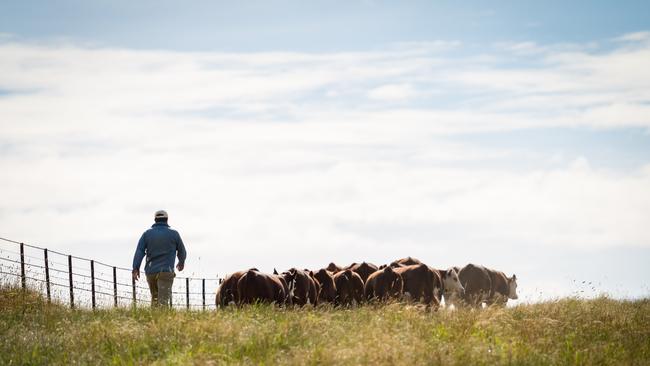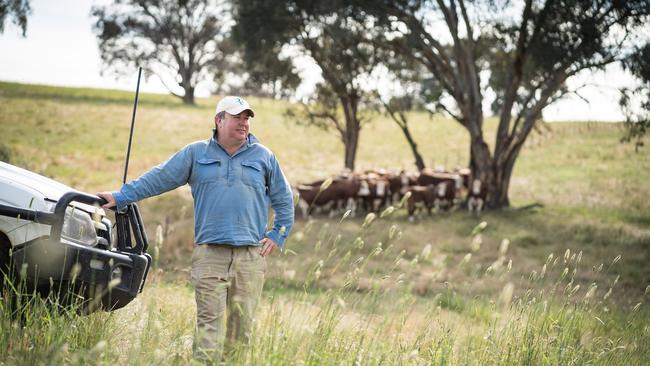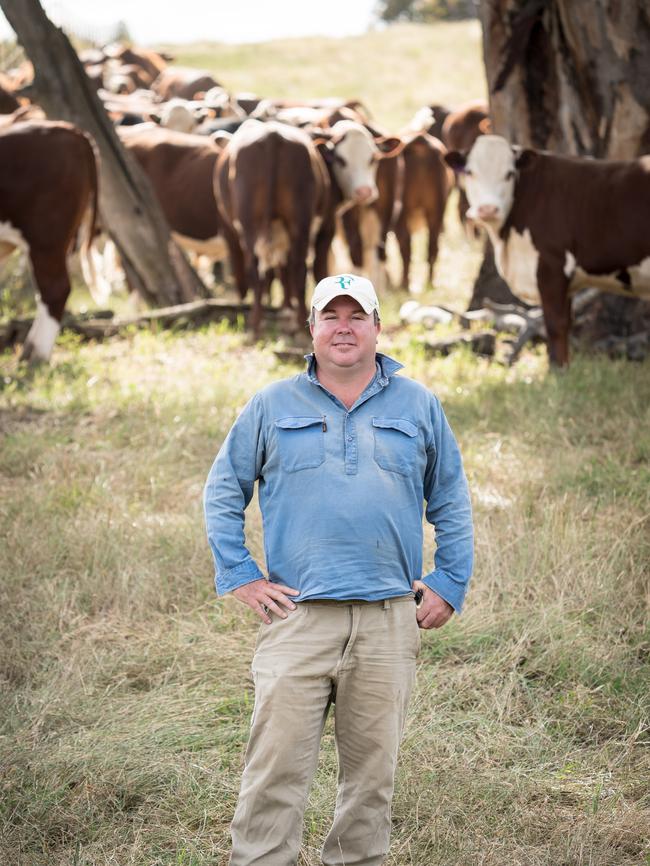Injemira Herefords: Marc Greening perfects steers for Coles Graze
Years in the past, Marc Greening’s bank manager “nearly got fired” for supporting Marc’s vision. Read his innovative story.
Flexibility and simplicity are the keys to success for a two-pronged beef business in the Riverina.
Marc Greening might run one of the best-known and successful Hereford studs in Australia – Injemira – but alongside it is a grass fattening operation turning off up to 3000 steers and heifers a year.
The stud and commercial beef enterprises are run across five properties, which total more than 4000ha in NSW at Holbrook, Book Book and in the Oberne Valley.
The operation started 21 years ago with a single property at Book Book and since then area has grown as the enterprise reached its desired targets.
“My bank manager recently told me that all those years ago, he nearly got fired for pleading the case for my vision,” Marc said.
The aim of the commercial operation is to have “1.6 stock turns a year,” Marc said, or the ability to turn off 1.6 steers for each hectare of country in a calendar year.
But the system is not based on pushing country, with only moderate fertiliser use on the rye-grass, clover and Phalaris pastures.
“Moderate but essential inputs means that in dry years, you are not exposing yourself from a cashflow and profitability perspective,” he said.
“We have our peak amount of feed in late winter, spring and early summer.
“This is when we have our peak stocking rate to utilise that grass.

“We don’t over fertilise or push the country because what’s the point of growing a heap of extra grass that costs you money to grow if it can’t be efficiently used? Always ask yourself the question, ‘will this input make me money?’.
“We don’t supplementary feed our commercial stock – it’s a simple system, which essentially means we stock heaviest when we have the feed and have sold almost all of the steers when the peak feed levels are gone.”
SUPPORT NETWORK
Steers are sourced in late summer at the weaner sales and ideally from Injemira bull clients.
This fits neatly into the Injemira beef business for a number of reasons.
Clients are supported when selling cattle, knowing they already have strong competition from Marc to secure numbers for his commercial operation. But Marc said it was always a business decision based on his own gross margins that determined whether he was able to secure clients’ cattle or not.
“They know that I will be in there bidding, but often I don’t get them and while I want to be able to buy them, it has to make sense financially for our commercial operation,” he said.

“When I do get my clients’ cattle, I know the genetics and the potential performance of them, and I can also provide feedback and bull buying assistance to those clients to help them fine tune their operation based on how I see their cattle perform – real world information is king.
“In 2021 we had some great carcass results with a Hereford steer recording a marble score 9 and two others recording marble score 7s and a whole B-double recording a marble score average of 3.1.
“It just proves the right Hereford steers can match it with any breed on grass.”
Ideally, steers are bought in at 280-340kg liveweight, and are landed on to one of the five properties to be finished.
They are immediately drafted into weight ranges and mob sizes of about 300. The lightest steers are sent to paddocks furthest from the yards as they will be the last to finish to target weights.
There is no formal rotational grazing program, but steers are moved around in their large mob sizes to manage feed levels and maximise growth rates.
PREMIUM MARKET
Weight gains average 0.78kg a head a day year round, peaking at 1.5kg a day during peak feed periods in spring.
Steers are usually retained for six to nine months with the majority turned off into the premium grass-fed market, to the Coles Graze brand.
To fit the grid, the steers must weigh between 220kg and 330kg dressed weight and carry 5-18mm of fat. The ideal animal for Marc is of a moderate maturity pattern with strong carcass shape and finished as a milk tooth with a 300kg carcass.
Marc aims to supply a B-double load of steers every week during late winter and spring.
Hitting the grid with the right cattle is key to ensuring a strong working relationship with Coles, Marc said, and he is thorough in his selection of what makes it on to the trucks.
Each steer is weighed, allocated 5 per cent shrinkage due to transport, and then given an assessed yield of 54 per cent.
“That is how you determine how those steers will fit into the grid on weight,” Marc said.
“Then you go through those steers one by one, and you draft out those that don’t have the right maturity pattern and desirable fat coverage.
“There are two extremes – there are the big old horned Hereford types that are destined to be a three-year-old bullock, so they have the weight, but they don’t have the cover or shape, and there is the other extreme which just get in on weight, but they have no shape at all, so they won’t yield.”

There are two options for the cattle that are not deemed suitable for Coles Graze. This year, due to the excellent season and large amount of feed, Marc will grow them out to bullocks and sell as three-year-olds.
This is a financial decision too, as it is more profitable this year to retain these steers and grow out than sell and swap over for higher priced, light steers. In other years, these steers might be sold to a feedlot or a processor with higher weight tolerance.
“They will come through next year at $3500 but so what?” Marc said.
“I sold their brothers for almost as much 12 months earlier – that is how the modern grass-fed market has changed the way producers think and the style of cattle bred.”
INCOME DIVERSITY
The flexibility of the system is key, Marc said, in ensuring it could remain simple and relatively low cost despite supplying one of the industry’s premium brands.
“We will turn off anywhere from 1000 to 3000 steers and heifers depending on the season,” he said.
“In tougher years, we can drop this number back and in better years, we can ramp it up.
“In that way, we are not having to supplementary feed – running dry stock (steers) means that if the season turns really tough, we will buy less or we can sell off and protect the feed we do have for our stud cattle, so those numbers are never under threat.
“That is our drought management policy.
“It is a beef business – we need to be able to maintain our stud herd numbers regardless of the season to supply our clients and generate revenue from this part of the business and being able to off load commercial cattle if the feed situation tightens makes sense.

“Yet we can also maximise the use of feed in the good season by trading and finishing cattle.”
Even if steers are bought and are destined for the domestic grass-fed market, there are options if the season turns bad. Two of the properties are EU-accredited and steers from these are eligible to supply various feeder markets.
A percentage of the heifers bought from clients are also joined and sold as PTIC heifers, with anywhere from 200 to 400 females sold annually. Marc said this was a great way to diversify income streams and create cash flow when slaughter cattle were not being supplied.
Yet the goal is always to maintain a steady flow of grass finished steers into the Coles Graze brand.
As for the higher buy in prices for the commercial arm, Marc said he was comfortable enough paying the increased rates knowing he was supplying a premium brand.
“In supplying a premium grass-fed brand, we know that we won’t have the associated sale costs and market exposure that we would if we just sold steers through the sale yards, so it is good business to know your buyer before you purchase,” he said.




